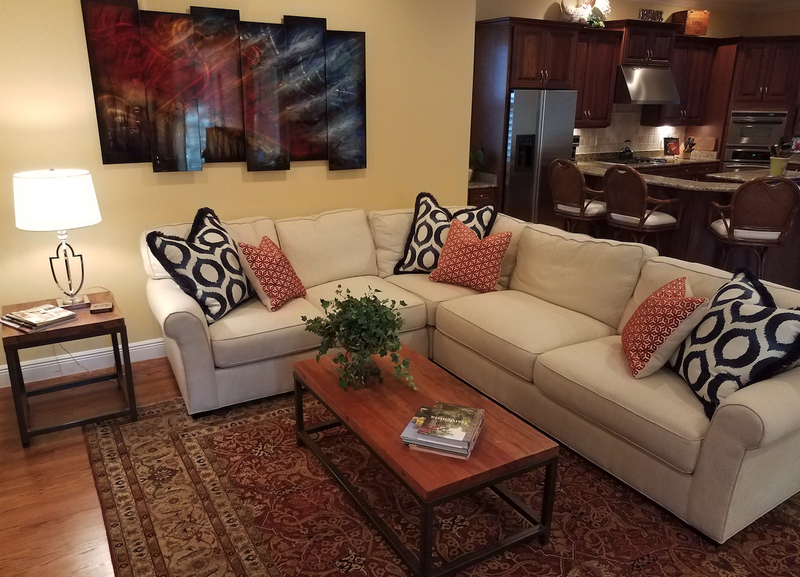A dozen throw pillow contestants lined the off-white corner sectional as if auditioning for a talent show. I stood back judging. Which would go?
Ever since the new family room sectional arrived — a decision that in itself cost me a dozen sleepless nights, two bottles of Excedrin and a pint of whiskey — I knew that I would soon have to face my next, even harder decor choice — picking the perfect pillows, ones that would tie the room together with a handsome bow, and be the room's piece de resistance.
You think I'm exaggerating. You think choosing throw pillows is easy. Well, though they may look like effortless afterthoughts, getting them right is an 11 on a difficulty scale of 10. You have to at once factor in shape, size, number, color, pattern, fill, style, durability, trim, edge detail, oh, and your partner's opinion, and do all that under the pressure of knowing that a room's success rises and falls on its perfunctory pillows.
I'd brought my 12 contestants home on a trial basis. The sales clerk understood completely. "You have to kiss a lot of frogs," I believe was her exact analogy. Kissing frogs would be preferable.
"Are you maybe overthinking this?" DC delicately asks when he sees the state I'm in.
"Not at all," I shoot back. "These pillows have a big job. They need to add pop and pizzazz, and get along with the other elements in the room, and bridge the traditional area rug with the modern wall art." As he slips out, I get to my point: "They need to be dramatic galvanizers!"
I thought I was up to the task. I wasn't.
"I need help," I said to Tina Crossley, a local interior designer, over the phone. "Will you come over?"
She took a look at the lineup. I stood back biting my nails down to the knuckles. She wrinkled her nose.
"None of them?" I said.
"They're nice, but not in here," she said. "You can do better."
"No, you can do better," I said.
This is where, as I have painfully learned, the judicious use of a professional designer can save you from irreversible brain damage. I paid Crossley by the hour to find pillow fabrics.
A week later she returned with four swatches. Two she didn't even take out of her bag, she was so sure of the other two. When I saw them, I was also. I ordered the fabrics, called my favorite fabricator, and two weeks later boom -- dramatic galvanization!
When faced with the challenge of choosing throw pillows for a furnished room, here's how Crossley suggests you tackle the task:
• Map it out. Decide how many pillows you want, what size and their placement. (One square pillow in each corner and a lumbar pillow in the middle? Two staggered pillows in each corner? Two on one side, one on the other? Pillows all across the back?) Most off-the shelf pillows come as 18- or 16-inch squares, and 18-by-12-inch rectangles. These work on most standard sofas. Bigger sofas and deep sectionals call for larger pillows. If you want that plush, inviting, sink-in-here feeling, you may need them custom made. For my corner sectional, Crossley recommended three 24-inch square pillows, with three 20-inch pillows staggered in front of them.
• Find your fabric. When dialing in color, Crossley asks, "What colors in this room do I want to repeat?" In my family room, the traditional rug and the modern art had burnt orange and ink blue in common, so Crossley used those colors as the bridge. The fabric's pattern should mesh with the sofa's style, whether modern, traditional, vintage or transitional. (You wouldn't want a modern geometric print on an antique brocade sofa.) Crossley opted for two transitional patterns: a small-scale burnt orange and cream print; and a large-scale dark blue and cream print. They relate to one another and to the transitional sectional, while also connecting the rug to the art.
• Don't shop blind. To streamline your search, have your colors and style in mind before you shop. Take swatches from the room and photos of art and rugs with you. "Don't do this from memory," she said. You still need to see the fabrics in your home, in your light, before you buy.
• Dial in details. To create a custom look, even on a ready-made pillow, consider adding a fringe, tape or a tassel. Pick your edges with a purpose, too. A knife-edge pillow looks clean. A welt adds a finished, tailored look, and fringe adds drama and texture. "Years ago, designers liked to layer and stack tapes and trims," Crossley said. "Today we minimize them. One is enough."
• Upsize your inserts. For a pillow to look full and not saggy, use inserts two inches larger than the finished size of the pillow covers. So use a 22-inch-square insert for a 20-inch pillow. Polyester fills are a good, inexpensive choice for pillows that need to just sit and look pretty because they hold their shape. But for pillows you want to fall into, go for down or down blend.
• Have patience. "Stay open, be critical, and keep trying until you find what clicks," she said. "Expect this to be a process."
Syndicated columnist Marni Jameson is the author of three home and lifestyle books, including Downsizing the Family Home -- What to Save, What to Let Go (Sterling Publishing).
HomeStyle on 12/15/2018

